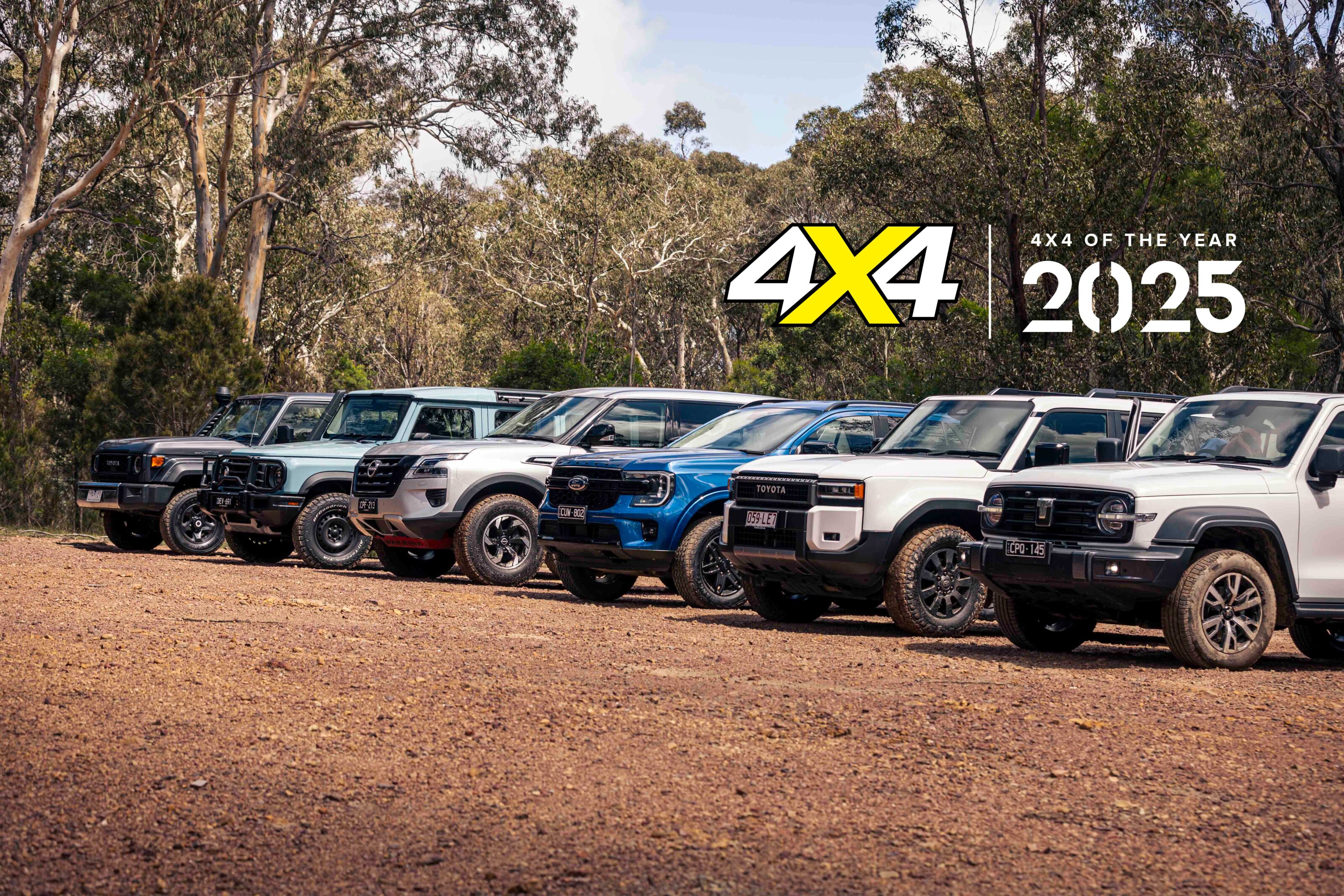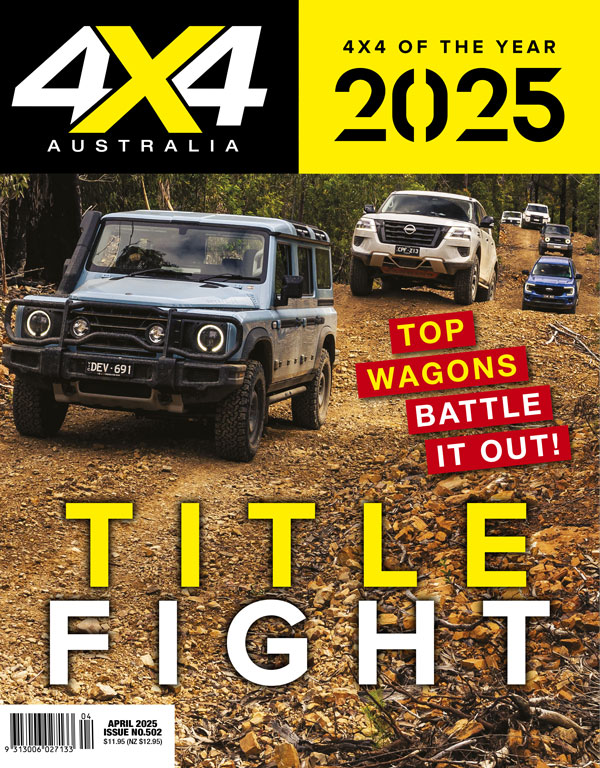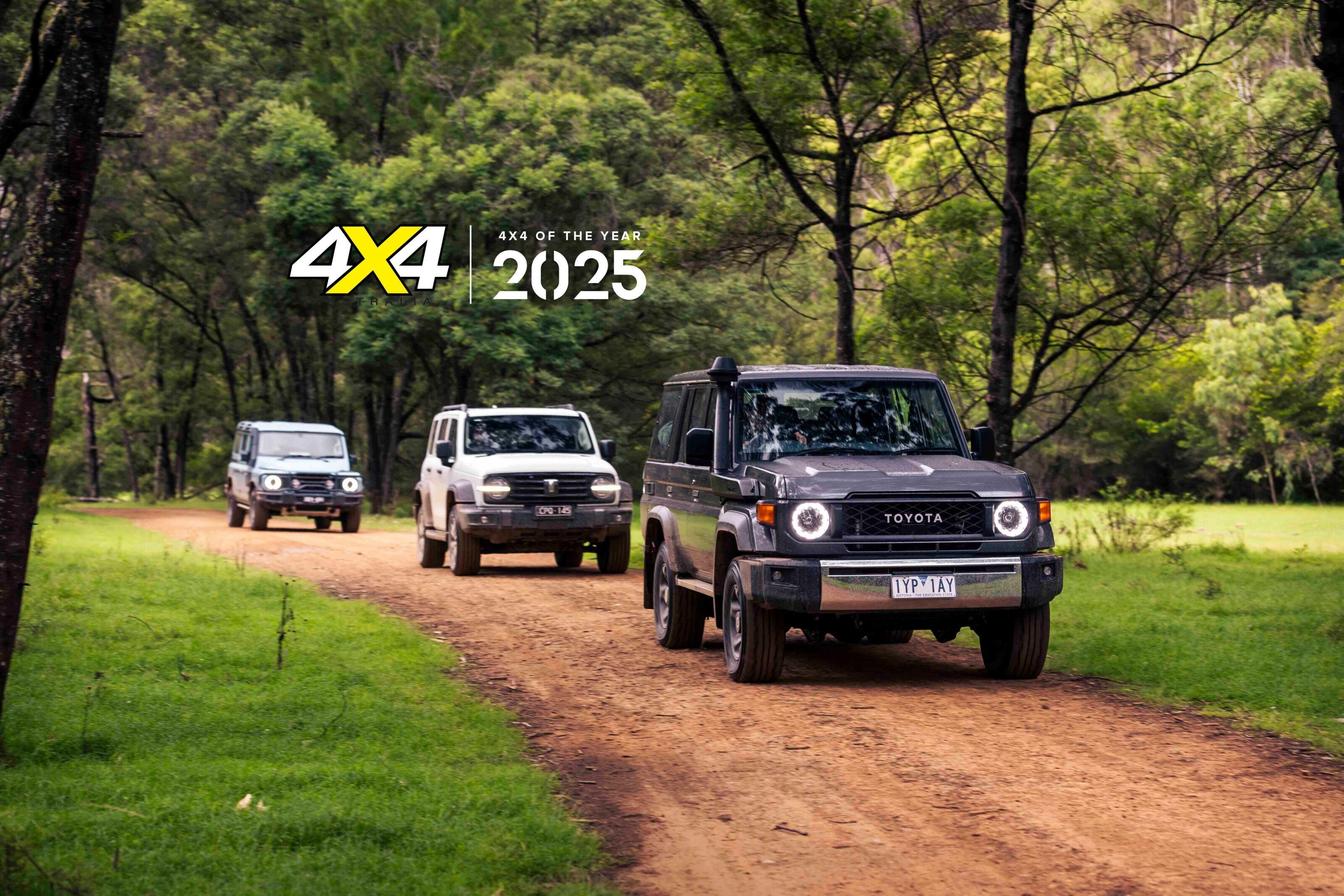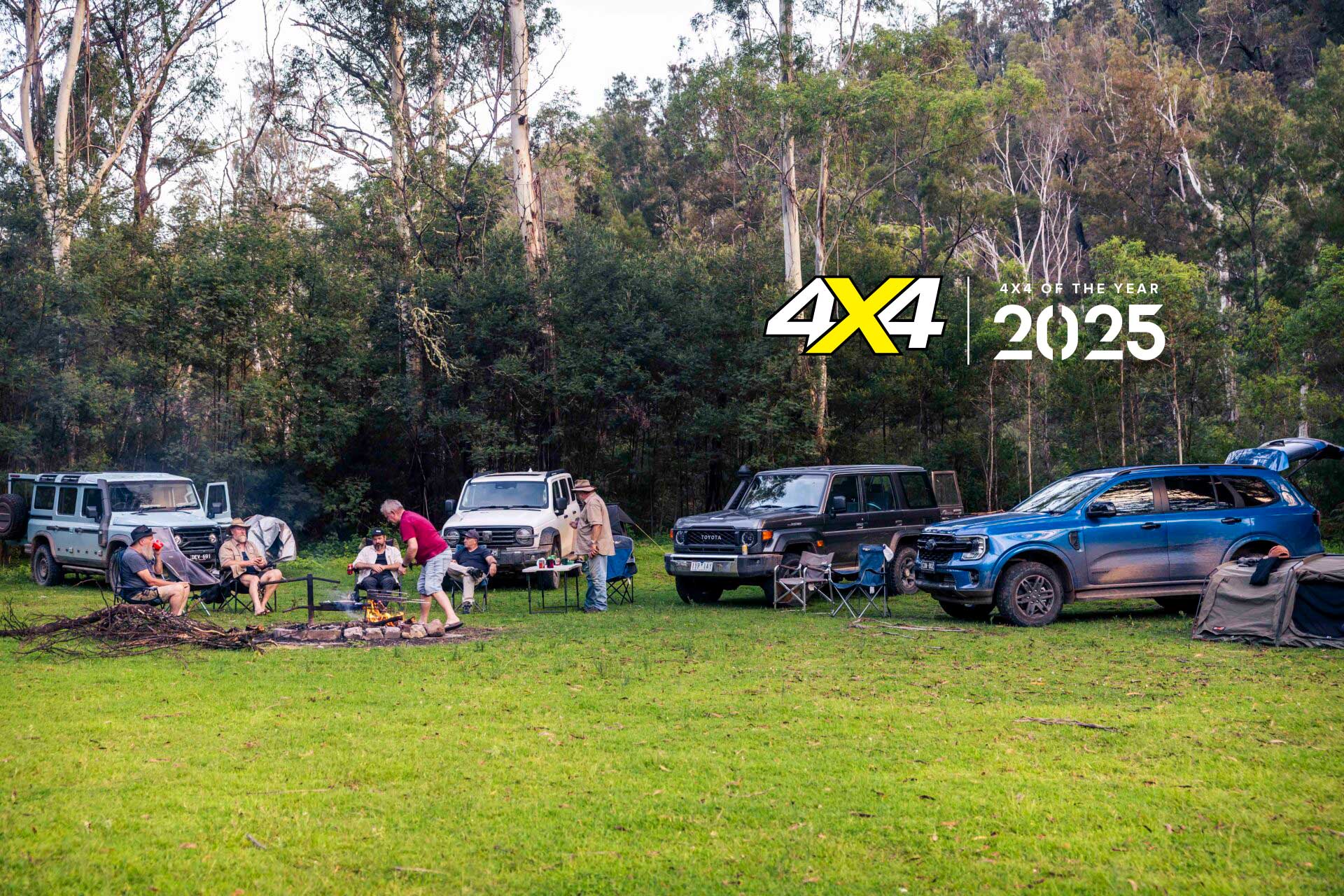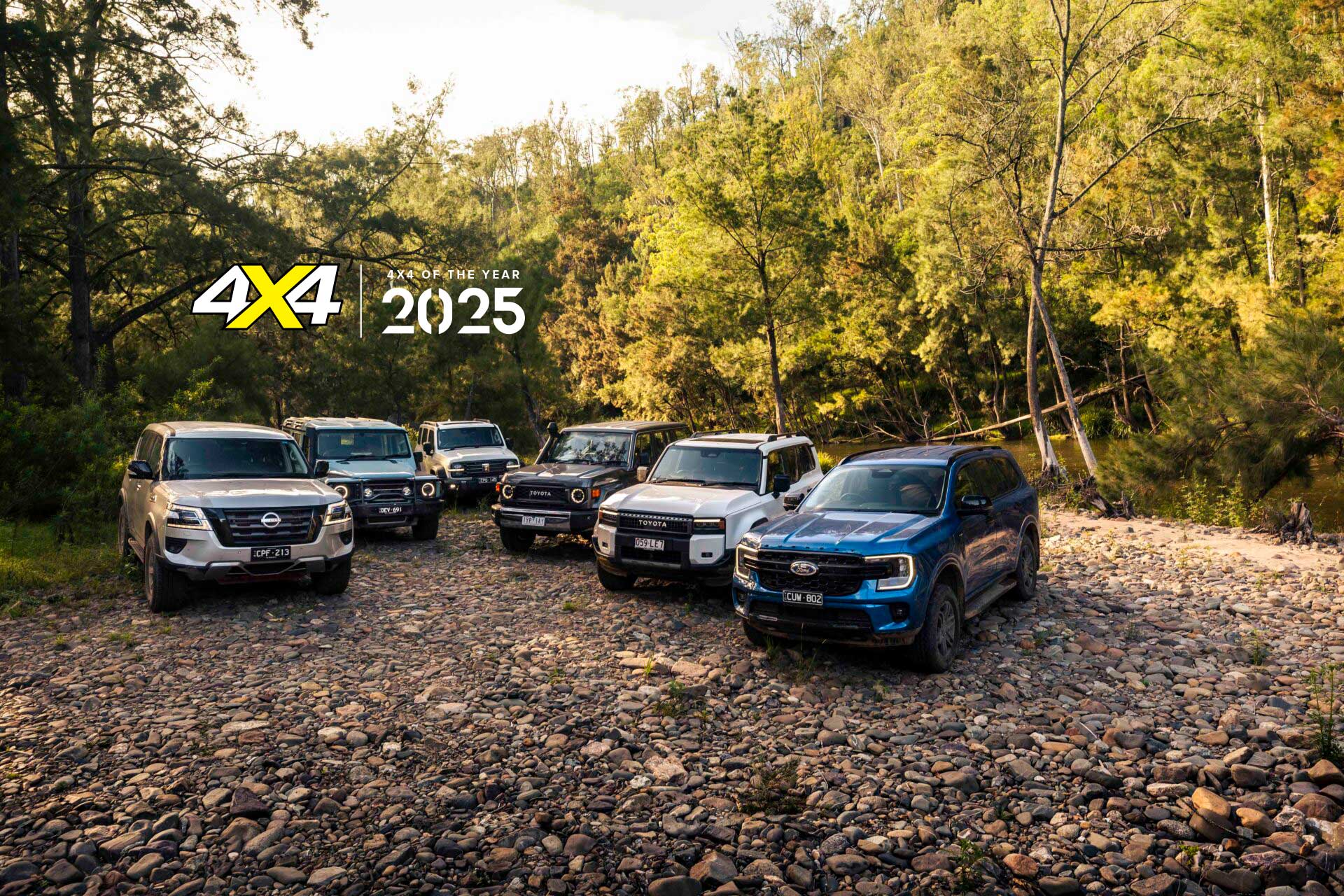We pulled together the best new 4x4s of recent times to see which is worthy of the 4X4OTY title. Here’s how each of the six contenders fared during the testing process 👇
- Ford Everest
- GWM Tank 300
- Nissan Patrol Warrior
- Ineos Grenadier
- Toyota LandCruiser Prado
- Toyota LandCruiser 76 Series
Ford Everest
The Ford Everest topped the Toyota Prado as Australia’s best-selling midsize 4×4 in 2024 and rightly so as this second-generation model offers a comprehensive package as a family touring wagon.
Admittedly, this was while Toyota was running out its stock of the old Prado but the Everest still has a lot to offer and deserves the sales title. At $76,590 (+ORC) the Everest Sport V6 we had on test is cheaper than all but the lowest grade 250 Series Prado GX meaning that it should be able to remain competitive in the sales race with the new Toyota in 2025.
The Everest Sport is a premium offering with leather seats, large multimedia screen, full suite of safety functions and a dual-range transfer case with multiple drive modes and a locking differential in the rear axle.
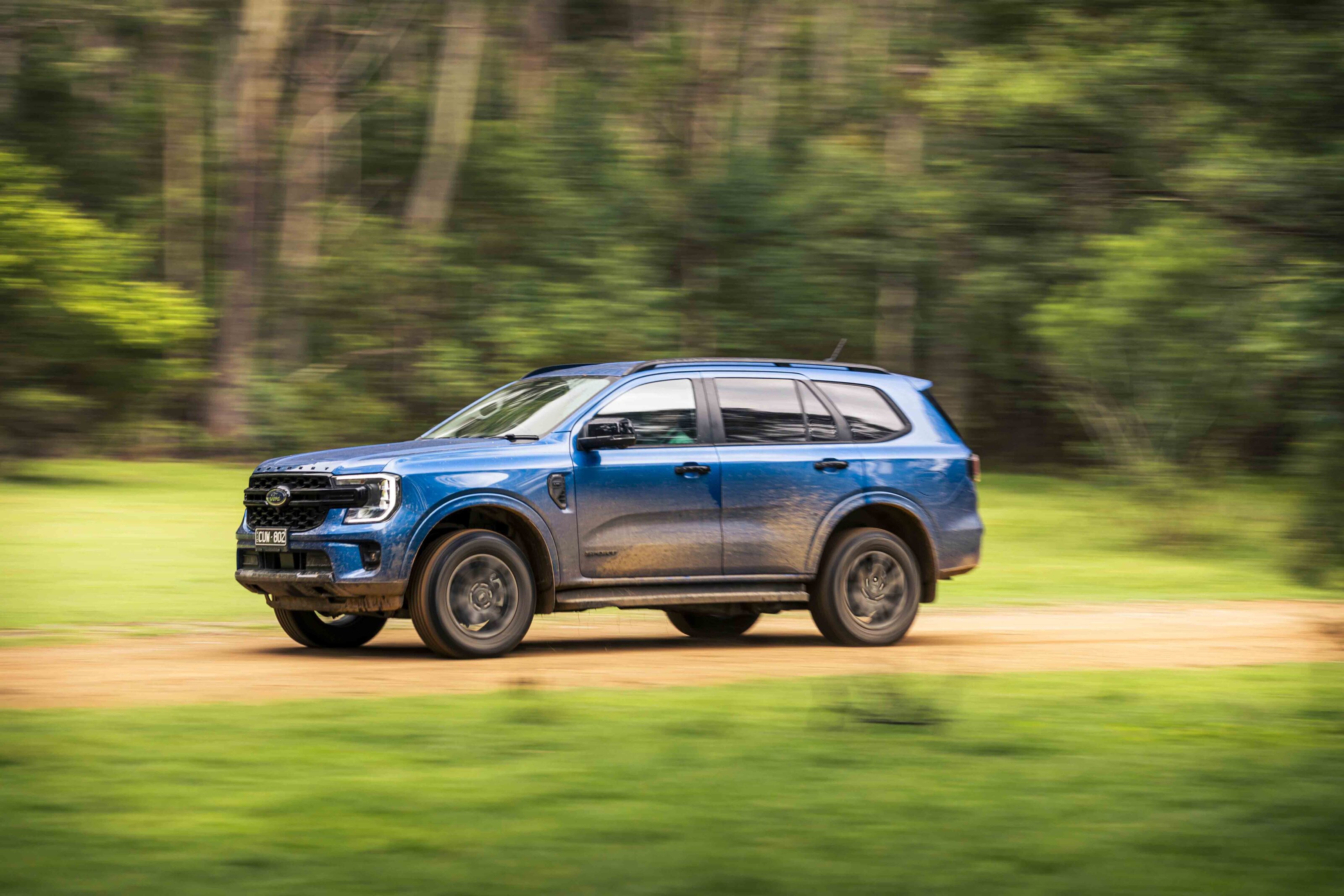
Its biggest selling point is its V6 diesel engine which, while relatively heavy on fuel use, offers refined performance and ability that nothing else short of a much more expensive LC300 can beat. The engine might be long in the tooth but it gives the Everest a level of performance that few other vehicles in the segment can match and significantly one of those is the 250 Series Prado.
The 4X4OTY testing showed many of the characteristics of the vehicles that we have noted during previous testing. Specifically for the Everest is that its ETC is slower to react than that in Toyotas which set the standard, and this allows the tyres to slip before traction control cuts in to arrest the slippage. As a result of this hesitation, the Everest scrabbles for traction in areas where other vehicles get through smoothly, so it really needs its locking rear differential to make it through.
The Everest’s off-road drive modes are also important here as we found that leaving it in the automatic setting or the wrong mode for the conditions has a negative effect on performance. This was evident when driving through the wombat holes where some drivers were making a meal of the sloppy conditions. Selecting the ‘Mud/Ruts’ drive mode certainly made a difference here as it sharpens up the ETC performance. Still, the RDL was needed for the best results.
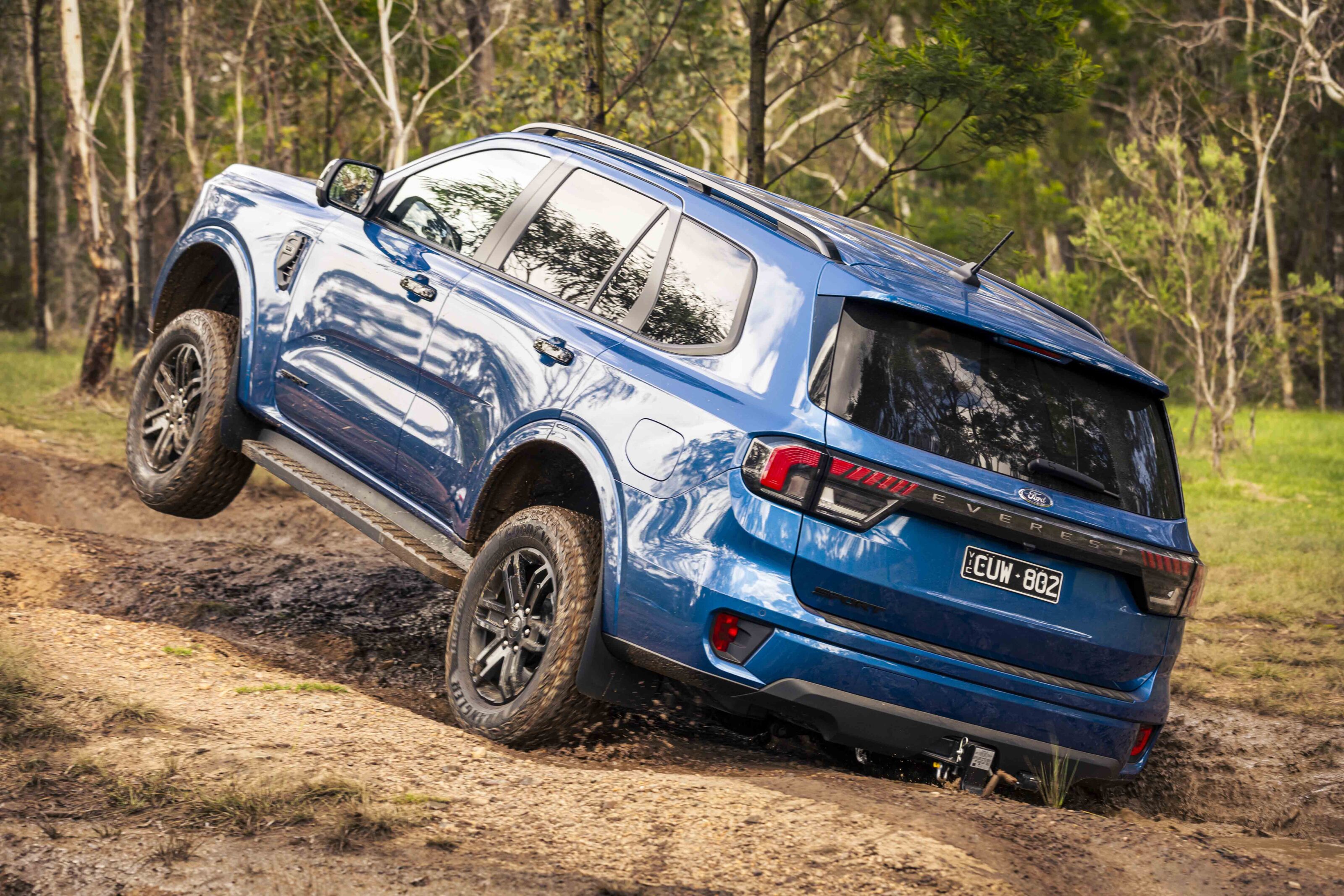
The Everest also revealed itself to be the lowest vehicle among our contenders, bottoming out on occasion when negotiating obstacles.
It was a similar story on the hill climb where some drivers couldn’t get the Ford up the most challenging hill, but selecting the more aggressive drive mode and using a light throttle eventually got it up there.
An annoying feature on the Everest compared to some of the other 4×4 vehicles in the Ford range – all of which use a similar if not the same system – is having to select the off-road screen to activate the RDL while other Fords have it at the touch of a button.
The Everest’s strong points are its well-equipped and generally functional cabin and its on-road performance. The seven-seat cabin delivers space for family travels and the third-row seats fold flat into the floor when not in use to make the most of the storage space.
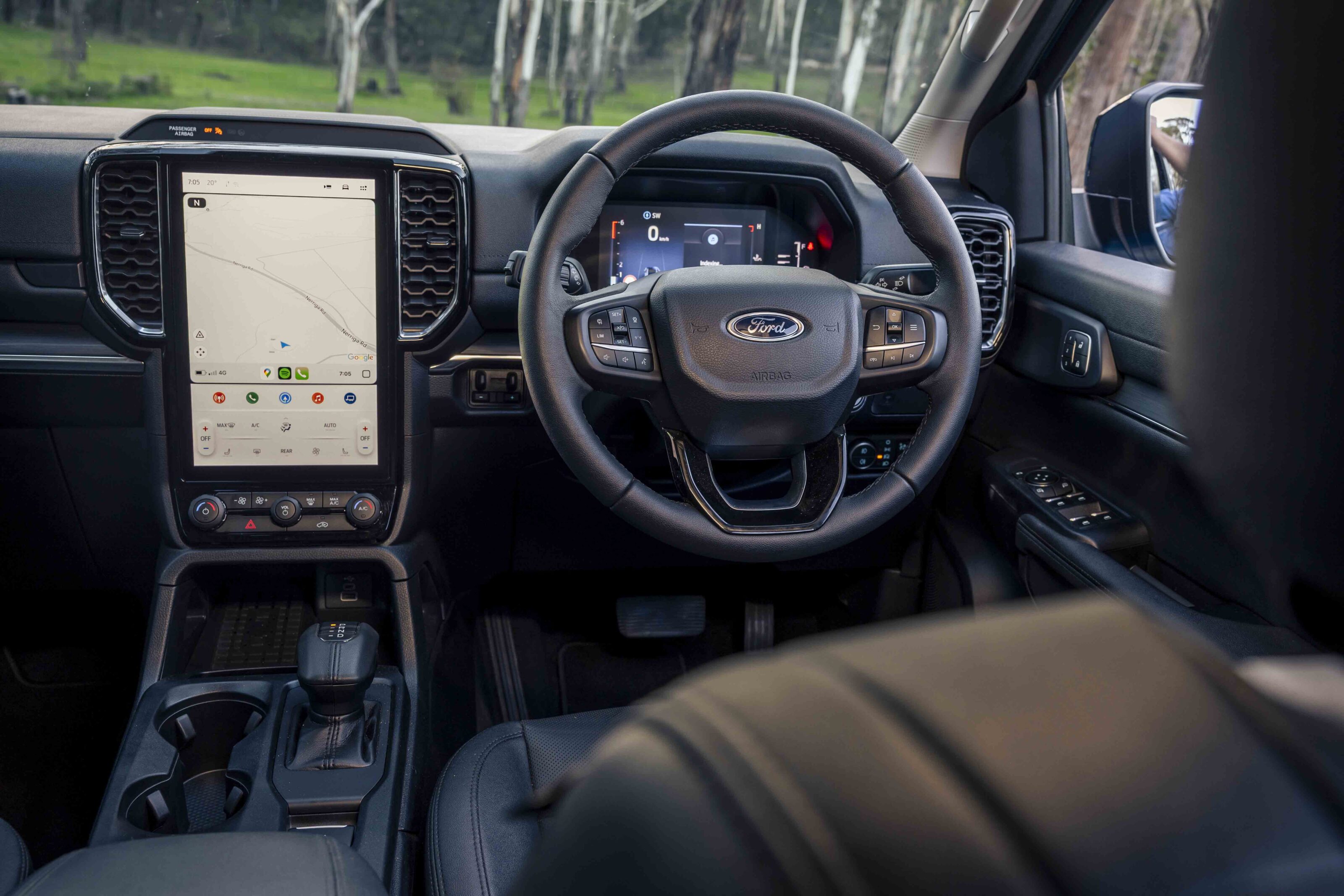
The large vertical multimedia screen is easy to read and use, and retains manual controls for cabin temperature and volume control that are easy to use without taking your eyes off the road.
The on-demand 4×4 system gives the driver on-road 4×4 traction which is great when driving on gravel roads and over crook surfaces. The suspension is beautifully dialled in for Australian road conditions making the Everest an excellent touring wagon.
Dave Morley said of the Ford, “Lacks a bit of suspension flex compared with this bunch, but in isolation it will take you wherever you want to go.” Ron Moon added, “Less intimidating in size than others in its class, the Everest has everything that most people will aspire to.”
| Ford Everest Sport specs | |
|---|---|
| Price | $76,650 +ORC |
| Engine | V6 diesel |
| Capacity | 2993cc |
| Max power | 184kW @ 3750rpm |
| Max torque | 600Nm @ 1750-2250rpm |
| Transmission | 10-speed automatic |
| 4×4 system | 2wd, 4×4 auto, and dual range locked 4×4 |
| Crawl ratio | N/A |
| Construction | 5-door wagon on separate chassis |
| Front suspension | Double wishbone IFS, coils |
| Rear suspension | Live axle, multi-links, coil springs, Watts linkage |
| Tyres | 265/60R18 on alloys |
| Kerb weight | 2492kg |
| GVM | 3150kg |
| GCM | 6250kg |
| Towing capacity | 3500kg |
| Payload | 685kg |
| Seats | 7 |
| Fuel tank | 80L |
| ADR fuel consumption | 8.5L/100km |
| On-test fuel consumption | 16.7L/100km |
| Approach angle | 30.2 |
| Ramp-over angle | 21.9 |
| Departure angle | 23 |
| Ground clearance | 226mm |
| Wading depth | 800mm |
GWM Tank 300
As the lowest priced vehicle in our group of finalists, the Tank 300 Ultra promised a lot of bang for bucks… and it delivered in spades.
Capable compact 4x4s are few and far between these days and the GWM Tank is a welcome addition as it fills a void in the market. The 300 is available in two grades of specification with either a 2.0-litre turbo-petrol engine or the same engine with hybrid EV assistance.
Now GWM has also introduced a diesel option just in time for our 4X4OTY testing, adding the 2.4-litre turbo-diesel engine from the 2025 Cannon into the mix, and that’s what we have here in Ultra trim. Great Wall’s diesel engine makes a claimed 135kW of power and 480Nm of torque, and it’s backed by a nine-speed automatic transmission.
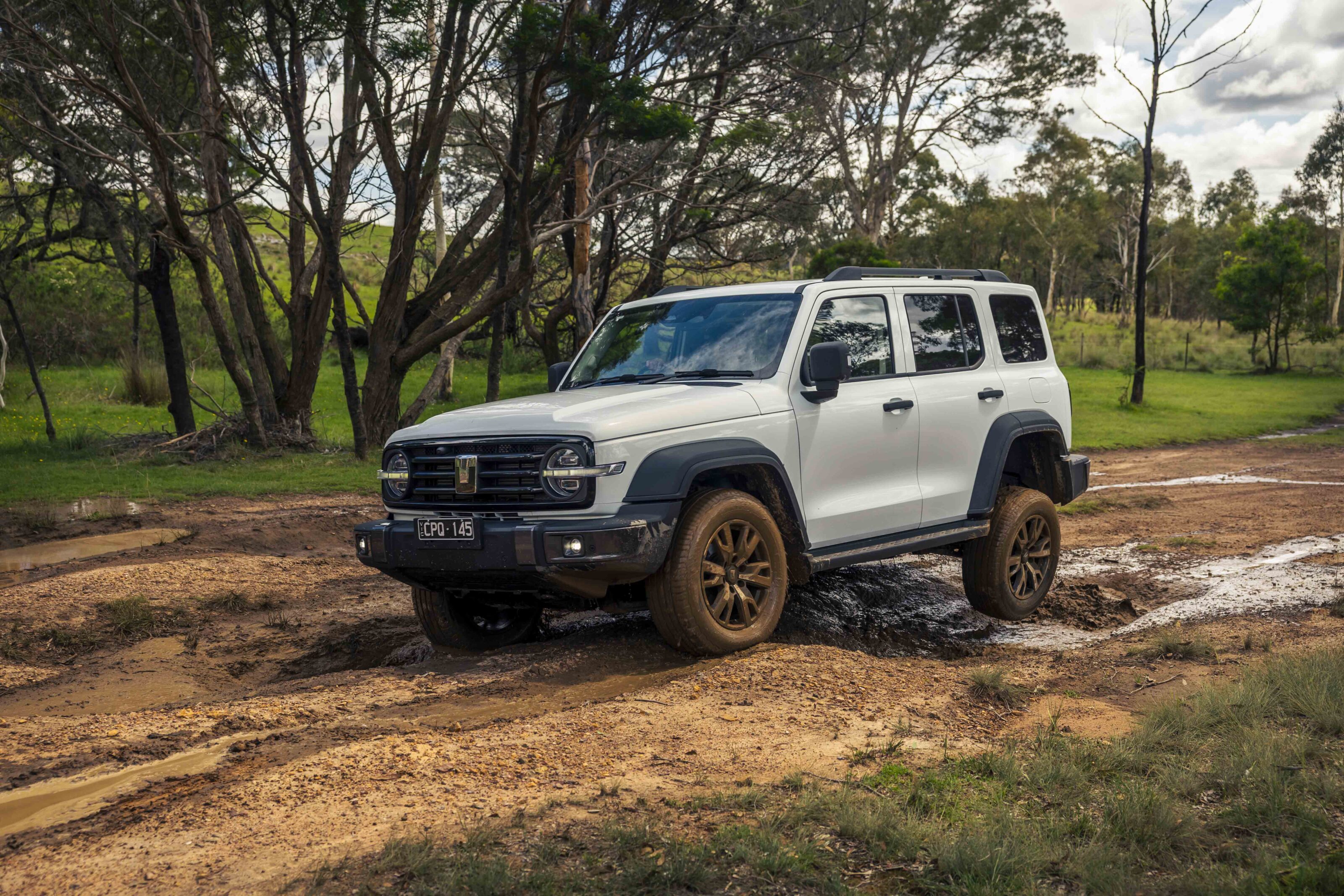
In $51,990 Ultra trim, the Tank is well equipped with leather accented power seats, a full list of ADAS and safety features, and a premium feel.
Despite being relatively compact in size the Tank 300 Ultra features a traditional body-on-frame construction with an IFS front end with coils and a live-axle rear with coils, with lockers front and rear, and high and low range in the transfer case.
On test, the Tank 300 impressed our judges from the outset with its premium interior and the way it tackled the wombat hole track and hillclimbs at Great Divide Tours with relative ease.
4X4OTY judge Dex Fulton, who drove the Tank down to Braidwood for the start of testing, said afterwards, “The Tank offers a lot for relatively little, and while it absolutely shines off-road (thanks to twin lockers and a fairly short wheelbase) and is decent on-road, where it’s really let down is by its engine which just doesn’t have enough poke.”
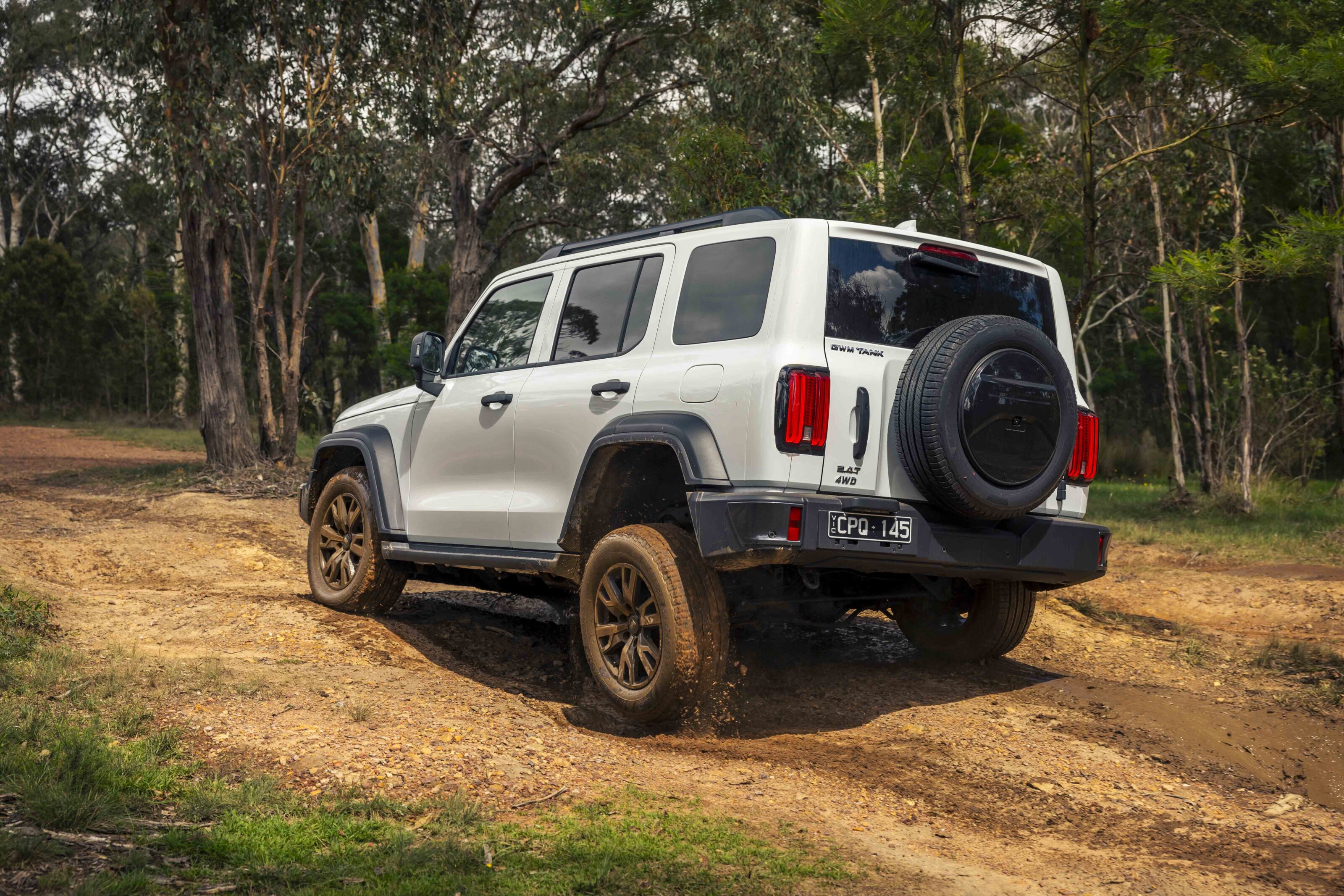
That lack of power was noted by a few of our drivers and came to the fore when the Tank failed to make it up that challenging hill on Merricumbene Fire Trail. As it climbed the engine sounded as if it was being held back, not revving or accelerating enough to create the speed to clear the crest. Whether that was the traction control holding it back or the transmission not shifting when the engine redlined in low range is unknown, but the result was that the Tank was the only vehicle to need assistance during our test drive.
Nevertheless, Ron Moon reflected many of our sentiments about the vehicle saying, “The Tank surprised with its comfort and offroad ability.”
| GWM Tank 300 specs | |
|---|---|
| Price | $51,990 drive away |
| Engine | I4 diesel |
| Capacity | 2370cc |
| Max power | 135kW @ 3600rpm |
| Max torque | 480Nm @ 1500-2500rpm |
| Transmission | 9-speed automatic |
| 4×4 system | On-demand dual-range 4×4 |
| Crawl ratio | N/A |
| Construction | 5-door wagon on separate chassis |
| Front suspension | Double wishbone IFS, coils |
| Rear suspension | Live axle, multi-links, coil springs |
| Tyres | 265/60R18 on alloys |
| Kerb weight | 2313kg |
| GVM | 2552kg |
| GCM | N/A |
| Towing capacity | 3000kg |
| Payload | 446kg |
| Seats | 5 |
| Fuel tank | 75L |
| ADR fuel consumption | 7.8L/100km combined |
| On-test fuel consumption | 16.6L/100km |
| Approach angle | 27.2 |
| Ramp-over angle | 23.3 |
| Departure angle | 21.3 |
| Ground clearance | 227mm |
| Wading depth | 500mm |
Nissan Patrol Warrior
If there was one vehicle in this group that really put a smile on the dial of the judges, it was the Nissan Patrol Warrior.
Dave summed up the big Nissan saying, “Proof that evolution can sometimes trump novelty. Beautifully resolved in all the important areas, especially the driveline. Brilliant off road and super capable on the highway. Only the relative lack of tech lets it down a bit, but that’s simply because the platform is so old. Huge value for money.”
The comments on the Warrior were positive across the week of testing and it was surprising that it didn’t score as well as expected. It is a capable and comfortable 4×4 wagon with proven credentials, the biggest and most comfortable interior by far, and a stonking V8 engine that will be sorely missed when the new Patrol arrives in 2026.
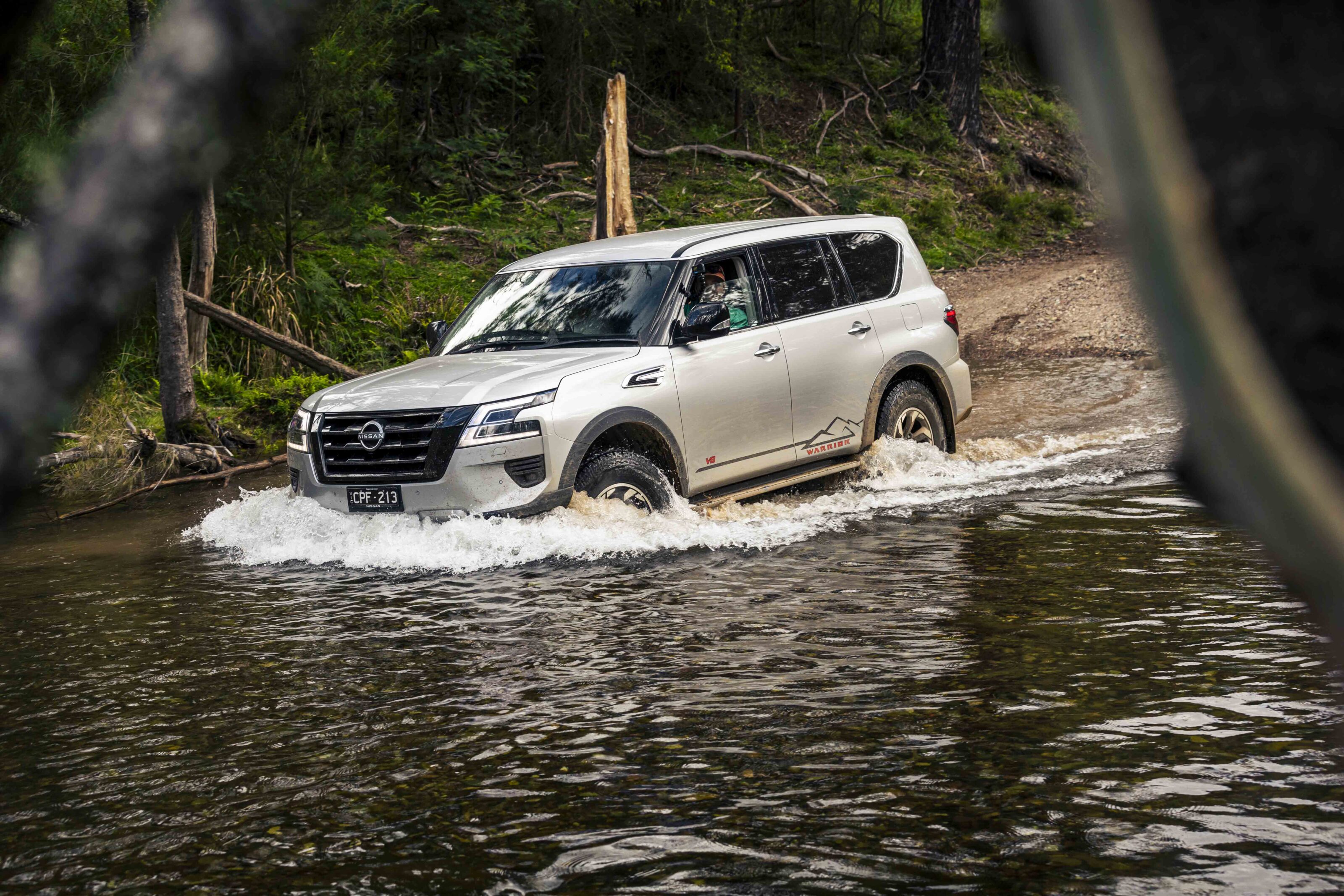
The Patrol might be getting on in age and is set for replacement at the end of 2025 but Nissan has done a stellar job by teaming up with Premcar to build a more focused and refined Patrol in the Warrior.
Premcar engineered a package that adds improved suspension, higher ground clearance, all-terrain tyres and a bi-modal exhaust system that lets the V8 roar when you put your foot to the floor. Combine these enhancements with interior trim upgrades in what is already a relatively luxurious cabin and the Warrior becomes a better mousetrap in all aspects of its design.
The Warrior made light work of the wombat holes and hill climbs but showed its age in the time its ETC takes to engage compared to the newer wagons, instead using its reserves of grunt to get it up and over obstacles. The Patrol has a rear diff lock as standard but add an aftermarket front locker to a Warrior and it would be virtually unstoppable.

The high levels of performance continue on the road where the Warrior is surefooted and stable on both sealed and gravel tracks. You sit high in the Patrol and it feels tall on its raised suspension and taller tyres, but never unsettled in any conditions. In fact, it feels ready for anything, anytime.
The age factor is again evident inside where despite Premcar’s efforts and a multimedia upgrade last year, the dash looks old and lacks some tech that new vehicles have standard, while the new multimedia system sits way too low in the centre stack. But the Patrol Warrior provided the most comfortable cabin among all the vehicles tested and it offered the most space for both passengers and cargo.
Dex said, “Easily the comfiest touring vehicle on test. The tweaked suspension, despite being independent all-round, soaked up everything we threw it at and the power (and sound!) from the V8 would get an easy “bloody mongrel” out of Alf Stewart.”
| Nissan Patrol Warrior specs | |
|---|---|
| Price | $101,160 +ORC |
| Engine | V8 petrol |
| Capacity | 5552cc |
| Max power | 298kW @ 5800rpm |
| Max torque | 560Nm @ 4000rpm |
| Transmission | 7-speed automatic |
| 4×4 system | 2WD, on-demand AWD and dual range locked 4×4 |
| Crawl ratio | 43.96:1 |
| Construction | 5-door wagon on a separate chassis |
| Front suspension | IFS, coil springs and HBMC |
| Rear suspension | IRS, coil springs and HBMC |
| Tyres | 295/70R18 on alloys |
| Kerb weight | 2884kg |
| GVM | 3620kg |
| GCM | 7000kg |
| Towing capacity | 3500kg |
| Payload | 736kg |
| Seats | 8 |
| Fuel tank | 140L |
| ADR fuel consumption | 14.4:1 combined |
| On-test fuel consumption | 16.3L/100km |
| Approach angle | 40 |
| Ramp-over angle | N/A |
| Departure angle | 23.3 |
| Ground clearance | 323mm |
| Wading depth | N/A |
Ineos Grenadier Trialmaster
To the group of four-wheel drivers that made up our judging panel, the Ineos Grenadier promised the most out of all our finalists.
A practical body on a separate chassis with lockable live axles suspended by coil springs and driven by a powerful six-cylinder diesel engine – it reads like a wishlist for any off road enthusiast or person working in remote terrain.
The Grenadier is also the only true, all-new vehicle here, coming from a new brand to the automotive world and starting from a clean sheet of paper – or pub napkin, as the story goes. Yet for something starting from a clean sheet design, the Grenadier has too many compromises from being instigated as an alternative for the old Land Rover Defender Classic.
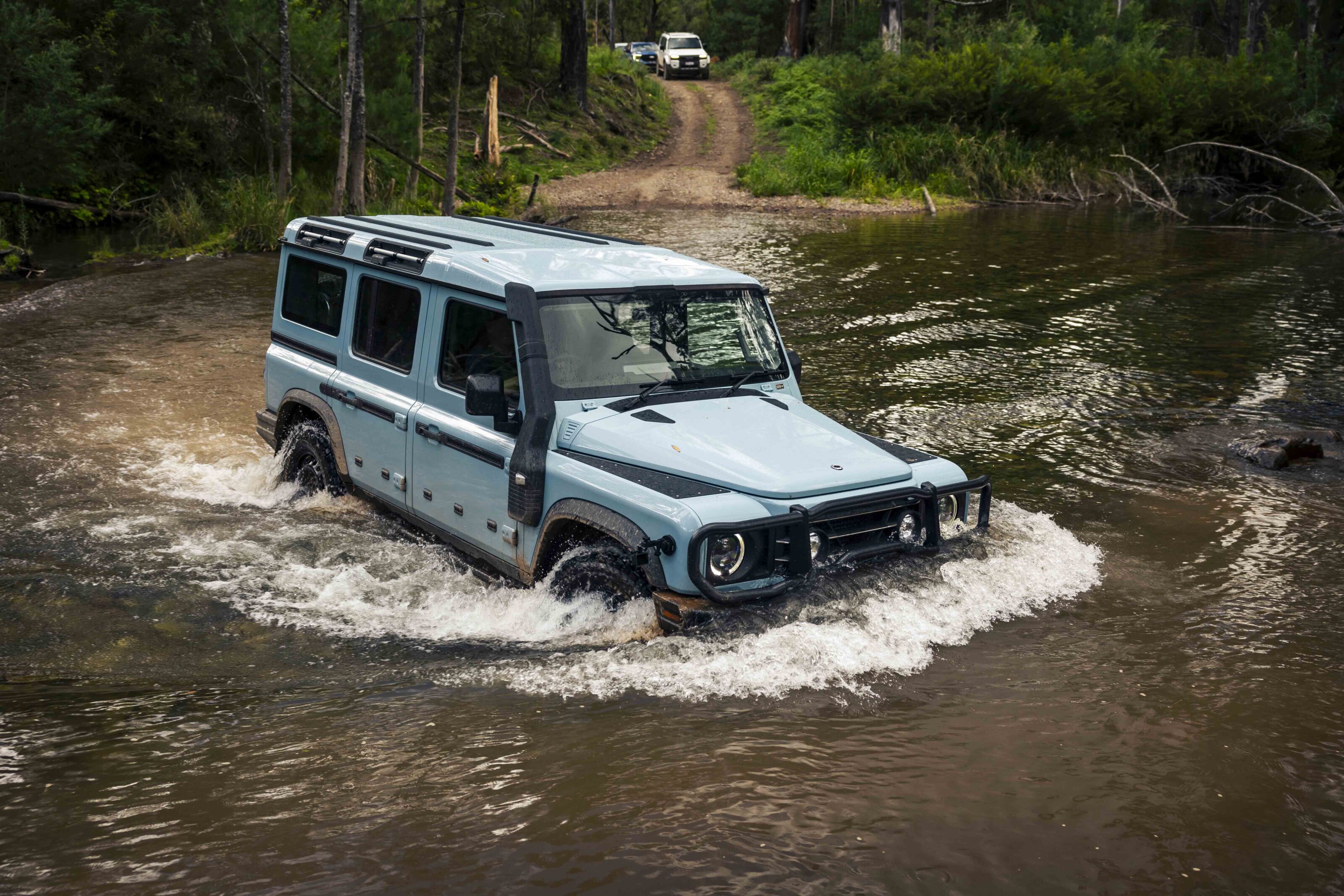
There were no complaints about the chassis and driveline in the Grenadier with the BMW-sourced inline-six diesel punching out plenty of grunt through a clever ZF transmission and triple locking differentials. It’s a mechanical package that feels bulletproof and ready to take on any terrain and conditions. As such it made light work of the obstacles and hillclimbs at the Great Divide Tours facility. Even with just the centre diff locked the Grenadier easily conquered most of the terrain, and any time it became more challenging it was only a matter of locking the rear and/or the front diff to get the job done.
But this is where the Grenadier became challenging for our drivers; the interior of the Ineos is a cramped and busy place in which to operate. The buttons for the lockers are placed up on the roof console along with the switches for auxiliary equipment and off-road mode. The buttons do have little metal loops next to them, and I’m sure that eventually, after enough use, you’ll be able to find them by feel without having to look up for them, but it really shouldn’t be that difficult.
Plenty of vehicle manufacturers tell us that ‘you will get used to it with time’, but we shouldn’t have to, especially on a new vehicle that has been designed from scratch as is the case with the Ineos Grenadier.
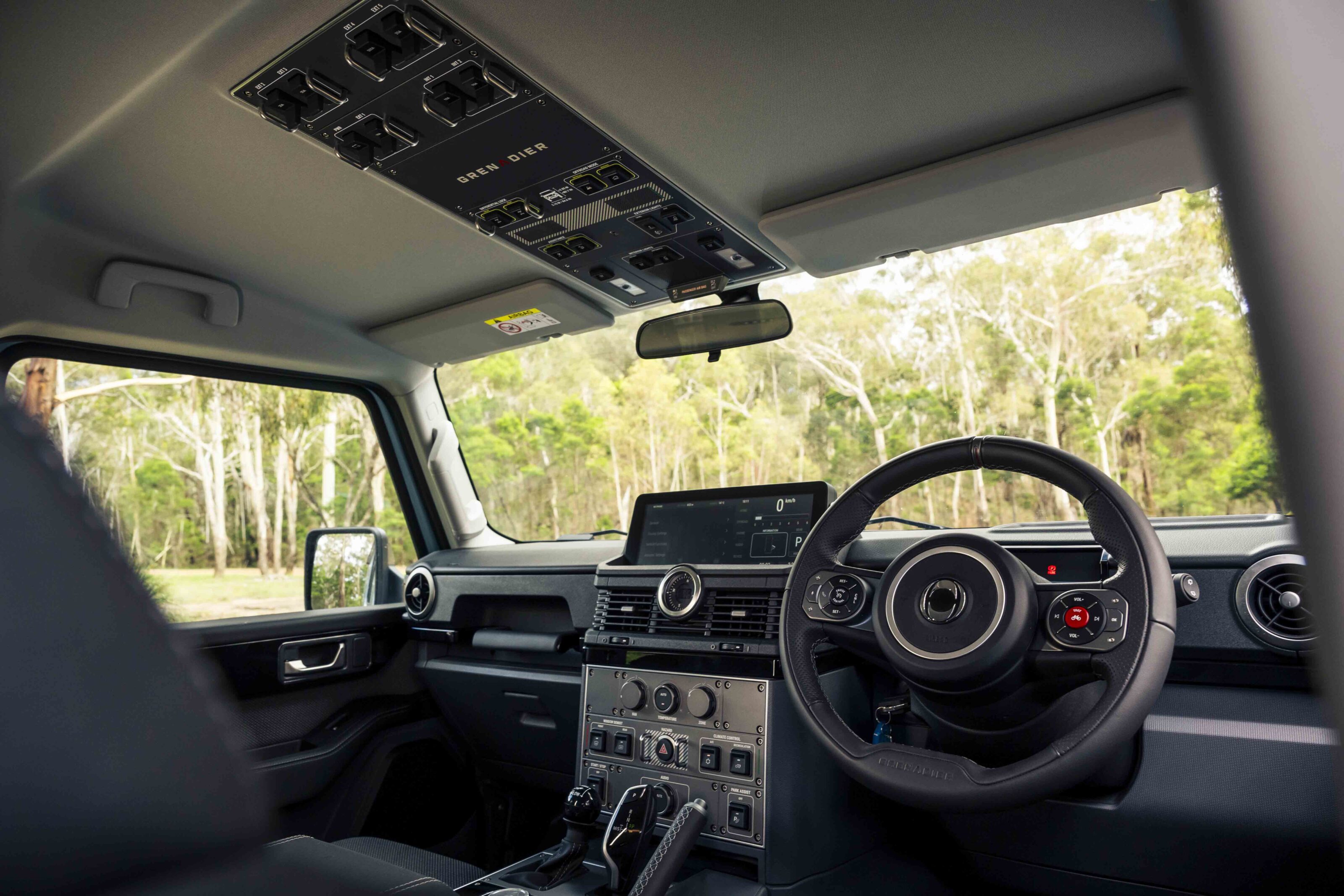
There are many niggly little things that make driving the Grenadier more of a chore than it should be, as much as we wanted it to be simple and easy.
As well as the built-for-purpose driveline and chassis, there are plenty of little things to like about the Grenadier; the standard fitment front and rear lockers, the Trialmaster spec’s dual-battery system under the back seat, the prewired roof panel for accessories like auxiliary lighting, the nifty mounts down the sides of the vehicle for attaching/securing accessories, and the pre-wired auxiliary switches are all useful additions to any off-road going 4×4.
The fact that the Grenadier was the only vehicle on test with a dual-battery system meant that it carried a fridge in the back for us, and it was able to be secured there using the standard tie-down points.
Dex noted, “A great idea has lost something between being drawn on the back of a bar napkin and making it into reality. The driver’s seating position is awkward; the switchgear takes some (a lot of) getting used to; the ride is agricultural compared to the others here.”
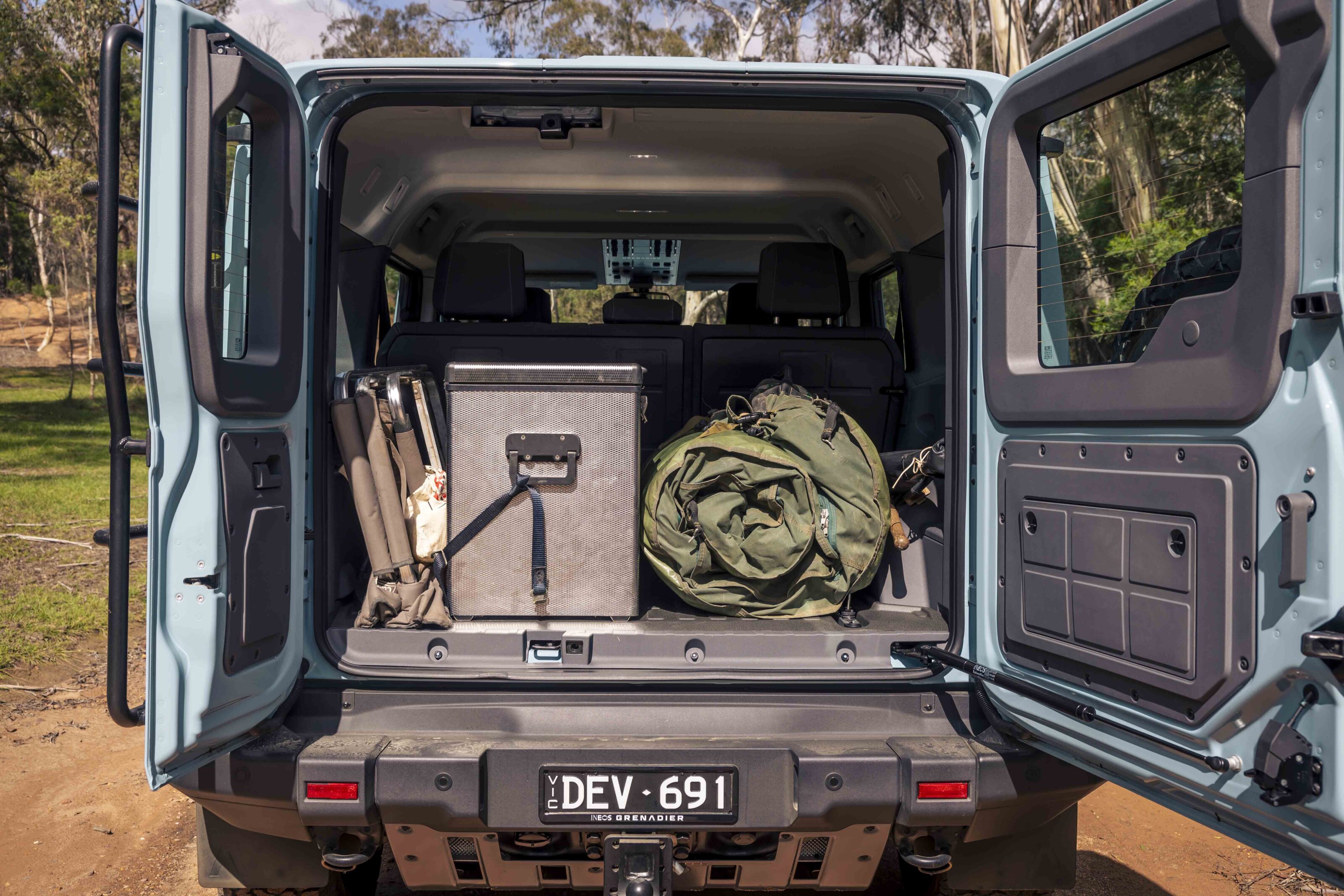
While great off road and on gravel tracks, the Grenadier’s on-road manners aren’t perfect and, while you might point to its live axles as a reason for this, the LandCruiser 76 doesn’t suffer from such ill road manners. The odd feeling of the Grenadier’s front end has been noted by many testers, not just us.
Dave said of the Grenadier, “Gorgeous driveline and absolutely fit for purpose, but I have doubts about how the front end is set up to be both slow steering yet still twitchy at speed.”
Ineos is obviously on to something with its Grenadier vehicles which are a welcome addition to a market in which 4x4s are generally getting softer, but there’s room for improvement and we’re sure that will come with time. For a first-time effort from an all-new automotive brand, the Grenadier is an impressive vehicle and we look forward to seeing future refinements.
| Ineos Grenadier Trialmaster specs | |
|---|---|
| Price | $123,000 +ORC |
| Engine | I6 diesel |
| Capacity | 2993cc |
| Max power | 183kW@3250-4200rpm |
| Max torque | 550Nm @1250-3000rpm |
| Transmission | 8-speed automatic |
| 4×4 system | Full-time 4×4 and dual range locked 4×4 |
| Crawl ratio | N/A |
| Construction | 5-door wagon on separate chassis |
| Front suspension | Live axle, coil springs, 5 links |
| Rear suspension | Live axle, coil springs, 5 links |
| Tyres | 265/70R17 AT |
| Kerb weight | 2718kg |
| GVM | 3550kg |
| GCM | 7000kg |
| Towing capacity | 3500kg |
| Payload | 833kg |
| Seats | 5 |
| Fuel tank | 90L |
| ADR fuel consumption | 10.5LL/100km |
| On-test fuel consumption | 17.5L/100km |
| Approach angle | 36.2 |
| Ramp-over angle | 28.2 |
| Departure angle | 36.1 |
| Ground clearance | 264mm |
| Wading depth | 800mm |
Toyota LandCruiser Prado Altitude
The most highly anticipated new 4×4 launch of 2024 was definitely the Toyota Prado 250 Series.
A long-time favourite wagon of families and off-road adventurers, the Prado has been a best-selling midsize wagon for decades. Thankfully, the new model isn’t a let down. The 250 Series sees the Prado grow in size, stature and price but it comes to a market hungry for just such a vehicle.
The Altitude model grade was best suited to our drive thanks to its all-terrain tyres on 18-inch wheels, rear differential lock and disconnecting front sway bar, but we also chose it as it is one of only two variants in the range to be offered with just five seats, and the third-row seating on models thus equipped impinges on cargo space more than we would want in a touring 4×4 wagon. We would have also considered the entry-level Prado GX for this test as it’s also a five-seater, and it’s the most affordable model in the range making it better value for money.

The new Prado continues to be the benchmark for midsize touring 4×4 wagons. It might be bigger than before but it still falls into that midsize bracket along with the Ford Everest and Isuzu MU-X, and being the newest vehicle to market it has plenty to offer the family traveller.
The bigger cabin of the 250 means there’s plenty of room inside for adults and passengers, and the dash is well laid out and easy to use without missing out on any features. Inside you’ll find a 12.3-inch multimedia screen that is compatible with wireless Apple CarPlay and Android Auto, Bluetooth connectivity and cloud-based inbuilt satnav; a panoramic moon roof; leather-accented seat trim with eight-way power adjustment, power lumbar support memory for the driver; and four-way power adjustment for the passenger seat.
There’s a 12.3-inch digital instrument cluster which only comes in the high-spec grades, as does the refrigerated console, the power-adjustable steering column and the JBL sound system kicking out the jams through 14 speakers. The Prado had the most comfortable, best laid out and equipped cabin of all the vehicles tested, whether you were driving on the road or off it.

Along with the rear locker, disconnecting front away bar and dual-range transfer case, the Altitude comes with multi-terrain selector with modes for rock, sand, snow, etc, as well as Crawl Control, which does an incredible job of maintaining steady progress over and up obstacles and tricky tracks without any application of the throttle by the driver. Crawl Control does this for you while distributing drive to the wheels with the most traction, making easy work of rough tracks; it really is one technology that even old school four-wheel drivers will appreciate.
The Prado’s 2.8-litre turbo-diesel engine makes a claimed 500Nm and it provides plenty of power for highway and off-road driving, but performance is best described as adequate rather than scintillating. The new eight-speed automatic transmission is quick to kick down and respond to a floored throttle, and the engine pulls well with that familiar four-pot diesel rumble. It doesn’t offer the performance or the refinement of Everest’s V6 but the 2.8 gets the job done.
The 48-volt mild hybrid system that is now part of the drivetrain does very little from a driver’s point of view other than display a range of lights and graphs on the dash. More significant are the restrictions it places on the rear cargo space and the ability to fit an auxiliary fuel tank under the back. Thankfully the Prado still carries 110-litres of good ol’ diesel in its single tank.
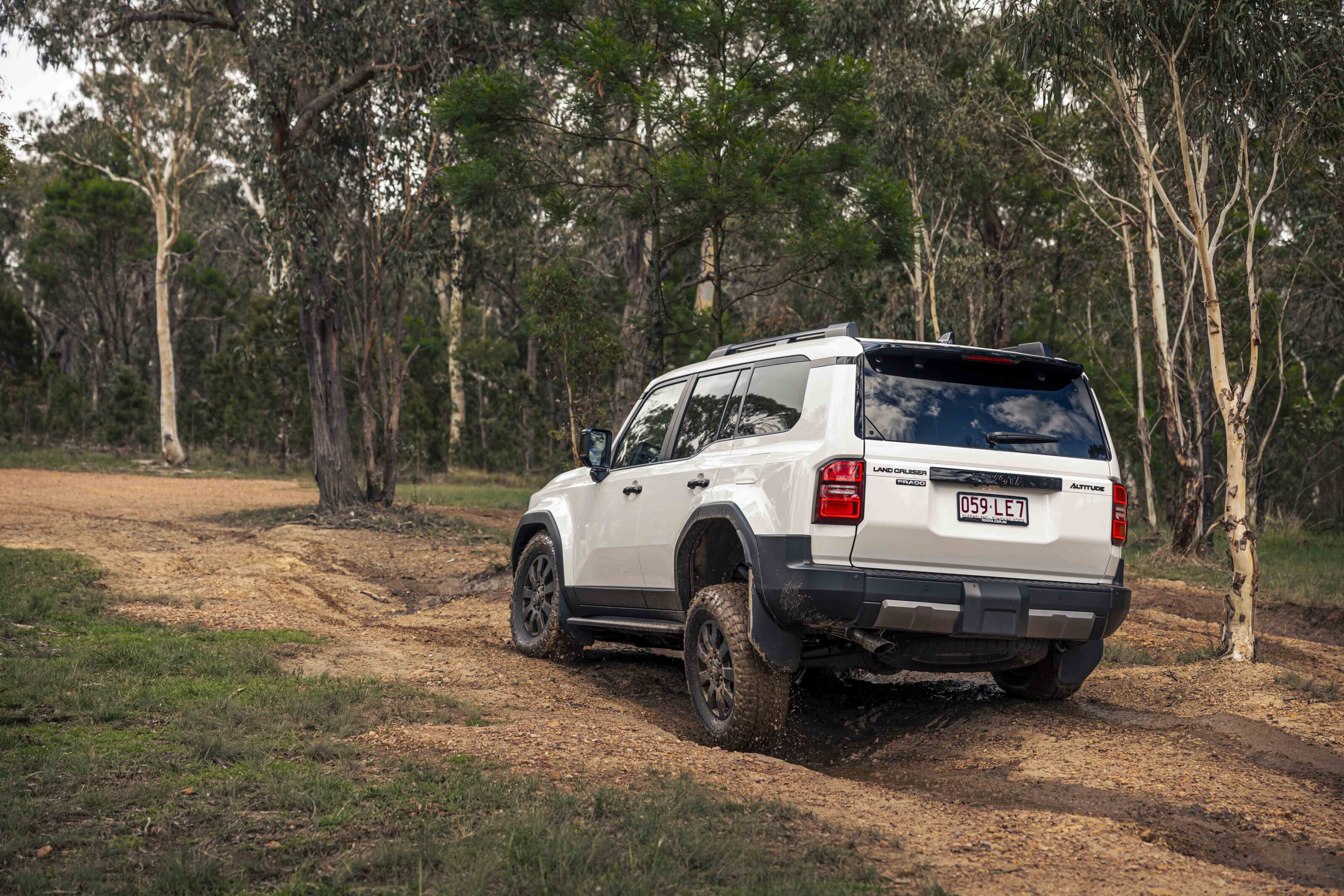
Whether you use the Prado for running around town or touring our wide brown land, the 250 Series is a very well executed 4×4 wagon that will tick all the boxes for many Australians. The compromises brought on by the packaging of the 48-volt system are the major blemish on its otherwise excellent design, but one we’re already seeing work-arounds for from the aftermarket. Whether or not all the upgrades to the 250 Series will be enough to justify the higher prices across the Prado range will be up to the buyer’s budget.
After driving the Prado Altitude, Ronny said, “Refinement, performance and comfort at a new level on road with impressive off-road capability.”
Dex sang its praises as well, saying, “I would not hesitate to hop in this thing and drive straight to the Cape and it’s equally at home on daily or towing duties. It seems to be a love it or hate it car, and I’m in the former camp. Fight me!”
Dave piped in with, “The absolute all-rounder of this lot. Great in the bush and safe, comfy and techy enough to be a daily driver. An excellent highway car, too. The Prado has finally earned the LandCruiser badge. A bit exxy, though”.
| Toyota Prado Altitude specs | |
|---|---|
| Price | $99,990 +ORC |
| Engine | I4 diesel |
| Capacity | 2755cc |
| Max power | 150kW@ 3000-3400rpm |
| Max torque | 500Nm@ 1600-2800rpm |
| Transmission | 8-speed automatic |
| 4×4 system | Full-time, dual range |
| Construction | 5-door wagon on separate chassis |
| Front suspension | IFS, wishbones, coil springs |
| Rear suspension | Live axle, coil springs multi-link, Panhard rod |
| Tyres | 265/65R18 on alloy wheels |
| Kerb weight | 2595kg |
| GVM | 3200kg |
| GCM | 6600kg |
| Towing capacity | 3500kg |
| Payload | 605kg |
| Seats | 5 |
| Fuel tank | 110L (17.4L Adblue) |
| ADR fuel consumption | 7.6L/100km |
| On-test fuel consumption | 15.9L/100km |
| Approach angle | 32 |
| Ramp-over angle | 25 |
| Departure angle | 17 |
| Ground clearance | 221mm |
| Wading depth | 700mm |
Toyota LandCruiser GXL GDJ76
While we mentioned the evolution of the Patrol Warrior over several years, in the case of the LandCruiser 70 Series that applies seven fold. The 70 Series has been evolving for 40 years and the changes made to the range in 2024 were wholesale.
The latest evolution is centred around adapting the 1GD-FTV 2.8 engine to the 70 to keep the well-aged model in line with emissions regulations that the diesel V8 simply wouldn’t be able to meet. The changes also introduced an automatic transmission to the range for the first time in decades. And the thing is, the four-cylinder engine and the auto transmission make the 70 better to drive than the V8 ever was in standard form.
The 2.8 engine is the same one found in the Prado 250 Series, the HiLux and the Fortuner… sans any hybrid interference. The auto slushbox is a six-speed Aisin unit that is well matched to the 2.8 engine. The new powertrain also heralded a fresh front-end design for the 70, and a smattering of new features, but it was really all about the engine and gearbox.
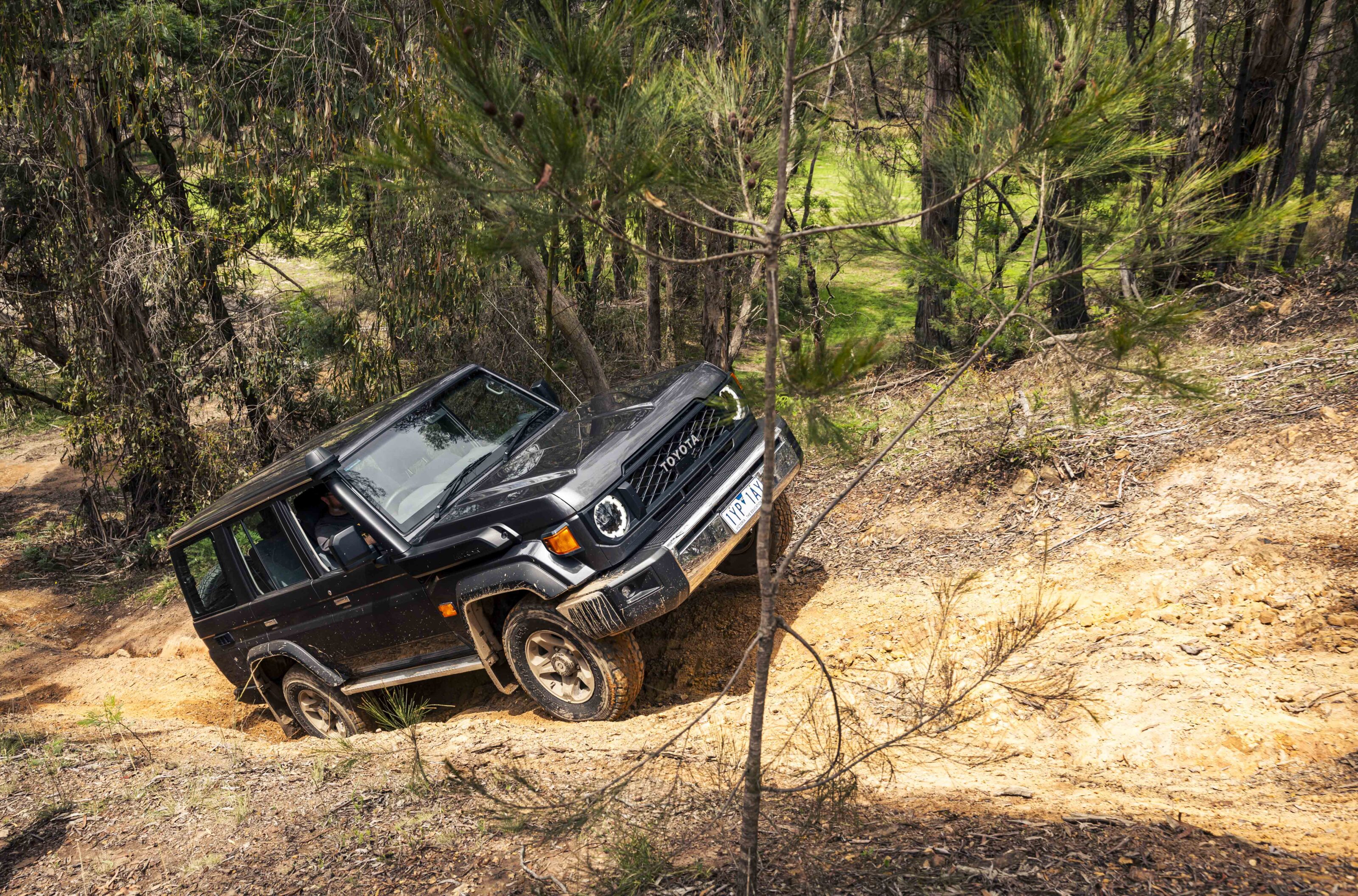
The LC76 wagon tested here in GXL trim was chosen for its front and rear locking diffs, power windows and cloth trim. As ever, the 76 remains a basic , no frills workhorse that gets on with the job, and that job is now easier for more people thanks to the new driveline.
Aside from the 1GD/auto powertrain and new tech under the skin, the only other changes are cosmetic. Toyota has doubled-down on the retro look with the revised front end reverting back to round headlamps ,albeit now with LED DRLs, a taller bonnet over a revised grille and lower venting that replicates the earliest 70s, and an upper vent atop the grille that is very reminiscent of the 40 Series.
Inside there’s a new gauge binnacle that also has a retro 40 Series vibe but includes a 4.2-inch information display with a digital speedometer, a new 6.7-inch infotainment screen, and a new steering wheel with more control buttons than before. Air-conditioning and cruise control are standard as are front and rear differential locks on GXL models (optional on lower grades).
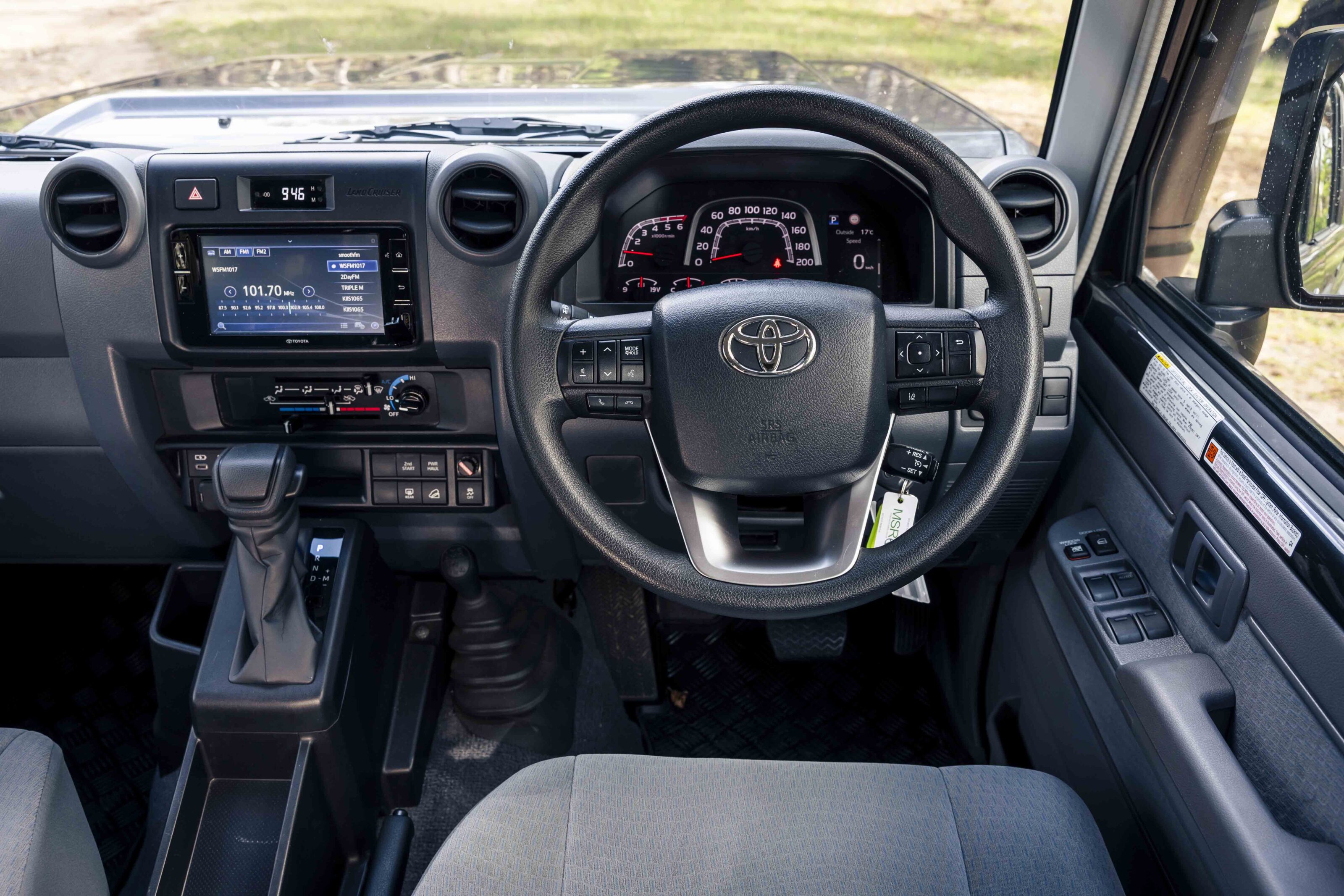
The 70 Series scores a bit of safety tech as well, but nothing like what you will find on all-new vehicles like the Prado and Everest. On the 70, Toyota’s Safety Sense system includes a pre-collision system with day and night pedestrian and daytime cyclist detection, lane departure alert with steering assist that works on the brakes and not directly on the Cruiser’s hydraulic power steering, speed-sign recognition, auto high beam lights, ABS, electronic stability and traction control, driver and front passenger airbags (but none for rear-seat passengers), downhill assist control on auto models only, and a reversing camera (only the four-cylinder/auto 76 wagon).
The LandCruiser 70 Series remains a very agricultural vehicle and its 40-year old architecture means that integrating the latest safety systems is a huge challenge for the engineers, but many 4×4 tourers will appreciate the lack of interfering safety tech. Having said that, the 76 does give you the occasional chime to warn you to keep in your lane, but that’s about it.
Evolving a vehicle over 40 years has allowed Toyota to get it right, and it has kept it simple with the 70 Series. The dash might hold a new gauge screen, but the infotainment (if you could call it that) screen is very basic. There’s now mapping, but the image from the reversing camera is below average and the sound system is simply woeful.
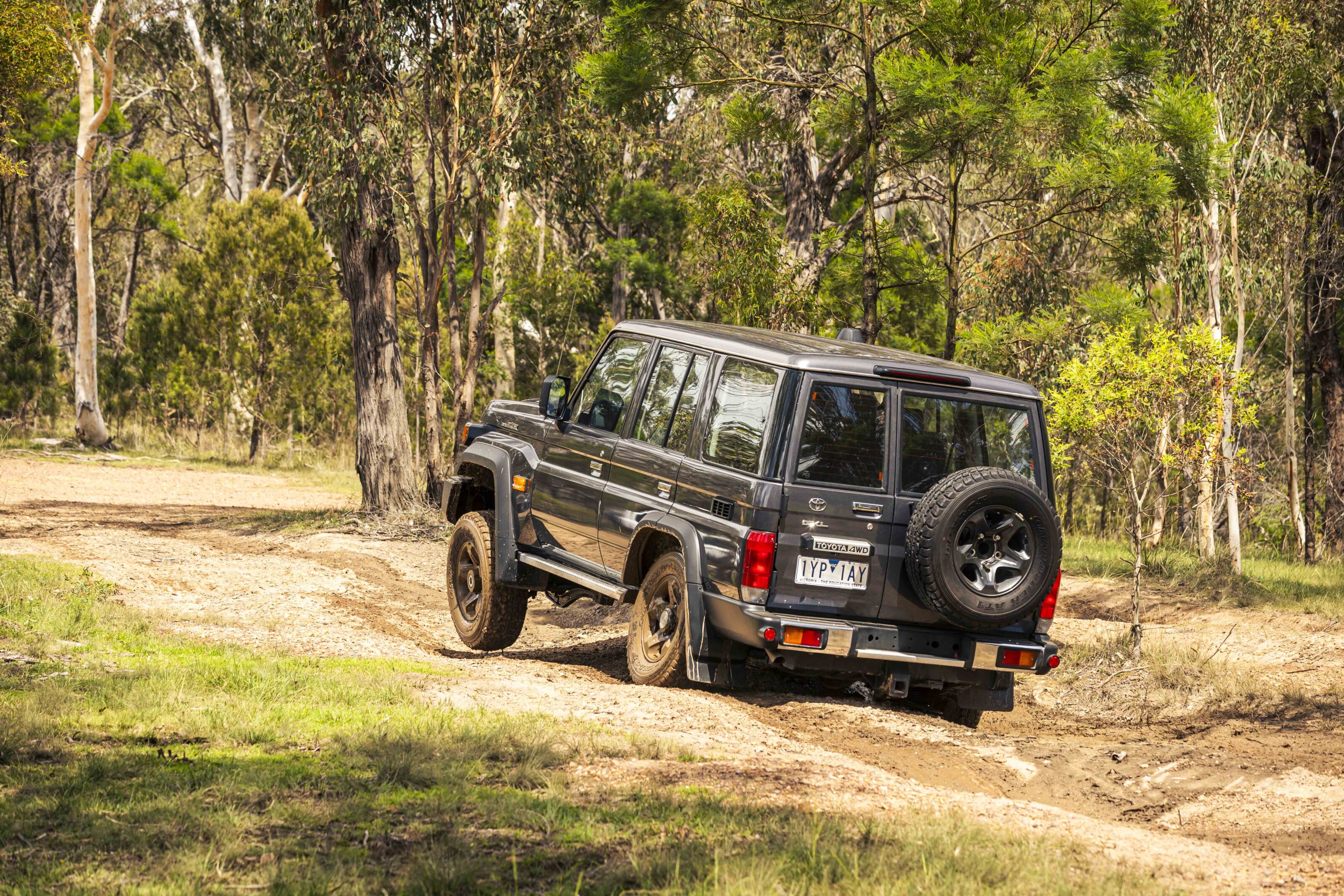
While short of luxury and convenience features, the 70 Series makes up for it with purpose-built functionality and capability. In a world of new 4x4s that try to be all things to all people, the 70 sticks to its roots and focuses on capability you can depend on, no matter what the conditions or terrain.
With unrivalled ground clearance and locking diffs just a simple twist of a dial away, the 76 is near on unstoppable in the bush. Visibility out of the 40-year old cabin is fantastic and the relatively small dimensions of the wagon make it easy to get around in the scrub and in the shopping centre carpark. It takes a day or two of familiarity before you get used to how manoeuvrable it is.
The cargo space is simply a square box with few protrusions to limit your load. The back seat folds forward or is easy to remove totally to make the most of that cargo space. Functionality at its best!
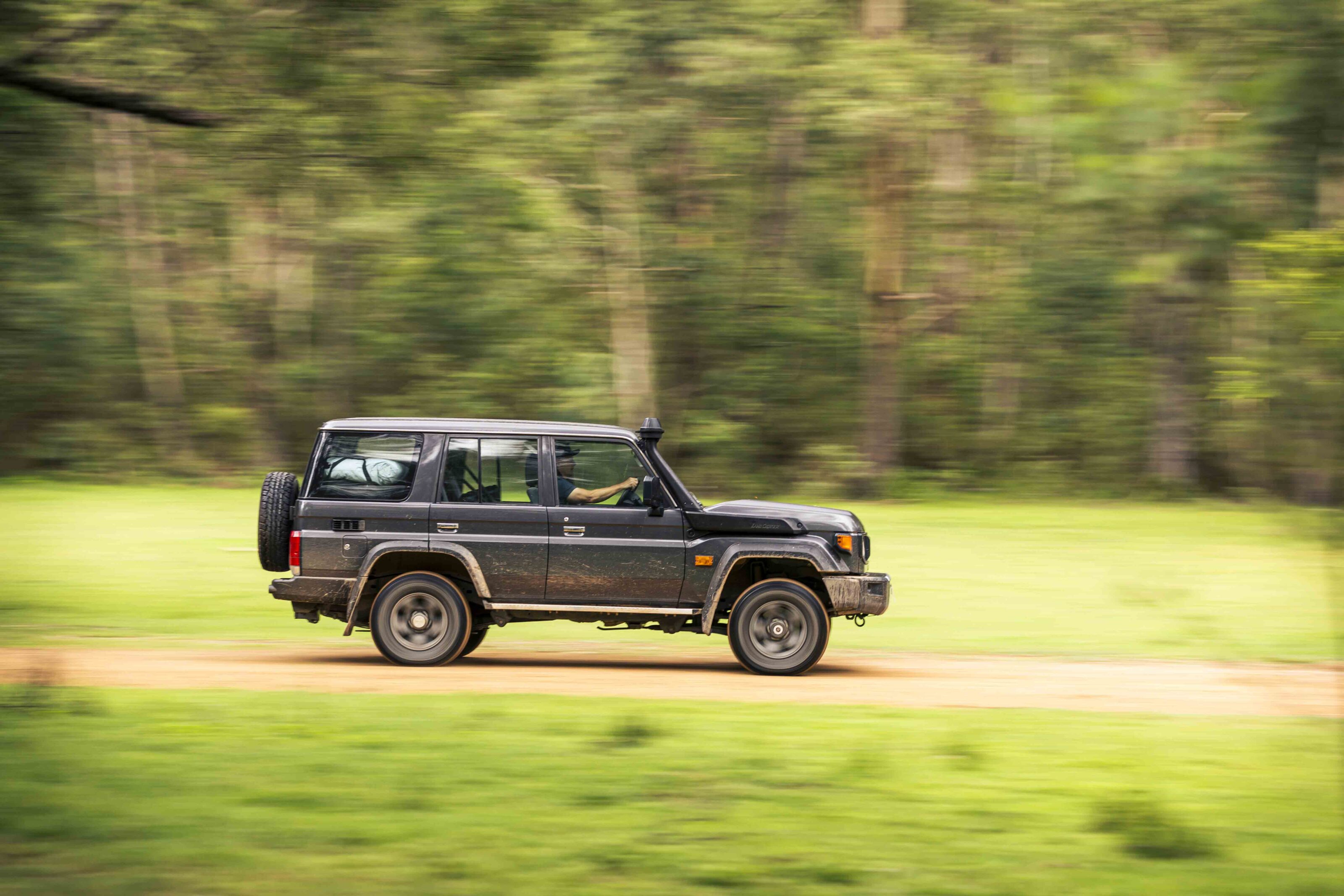
It’s this level of functionality and off-road capability that allowed the LC76 to score so well with our team of drivers. 4X4OTY is judged by a team of four-wheel drivers, not soccer mums, and we’re sure the result would have been different if it were, but we make no excuses for that. We are 4X4 Australia, after all.
Ron Moon loved the 76 saying, “What a difference a new – well new to the 70 Series – engine and a gearbox makes to this venerable workhorse… and in the wagon it works exceptionally well.”
Both Dex and Matt said this is the vehicle they would buy from the group, with Dex adding, “The auto is what the 70s have been missing since day one. It makes an already capable tourer into an easy daily driver and family wagon. I didn’t love or hate the 2.8L; the diff locks make hardcore tracks a possibility.”
Dave wrapped it up saying, “Old school for sure, but still a relevant vehicle. The new driveline is a belter and probably shouldn’t be as good as it is. The vastly improved fuel consumption and offer of an automatic gearbox also makes the live axles and prehistoric cabin design somehow less problematic. Brilliant in the scrub!”
| Toyota LandCruiser GXL GDJ76 specs | |
|---|---|
| Price | $79,800 +ORC |
| Engine | I4 diesel |
| Capacity | 2755cc |
| Max power | 150kW @ 3000-3400rpm |
| Max torque | 500Nm @ 1600-2800rpm |
| Transmission | 6-speed automatic |
| 4×4 system | Part-time, dual range |
| Crawl ratio | N/A |
| Construction | 5 door wagon on separate chassis |
| Front suspension | Live axle, radius arms, coil springs |
| Rear suspension | Live axle, leaf springs |
| Tyres | 265/70RR16 on alloys |
| Kerb weight | 2300kg |
| GVM | 3510kg |
| GCM | N/A |
| Towing capacity | 3500kg |
| Payload | 1210kg |
| Seats | 5 |
| Fuel tank | 130L |
| ADR fuel consumption | 9.6L/100km combined |
| On-test fuel consumption | 15.1L/100km |
| Approach Angle | 33 |
| Ramp-over angle | N/A |
| Departure angle | 23 |
| Ground clearance | 290mm |
| Wading depth | N/A |
We recommend
-
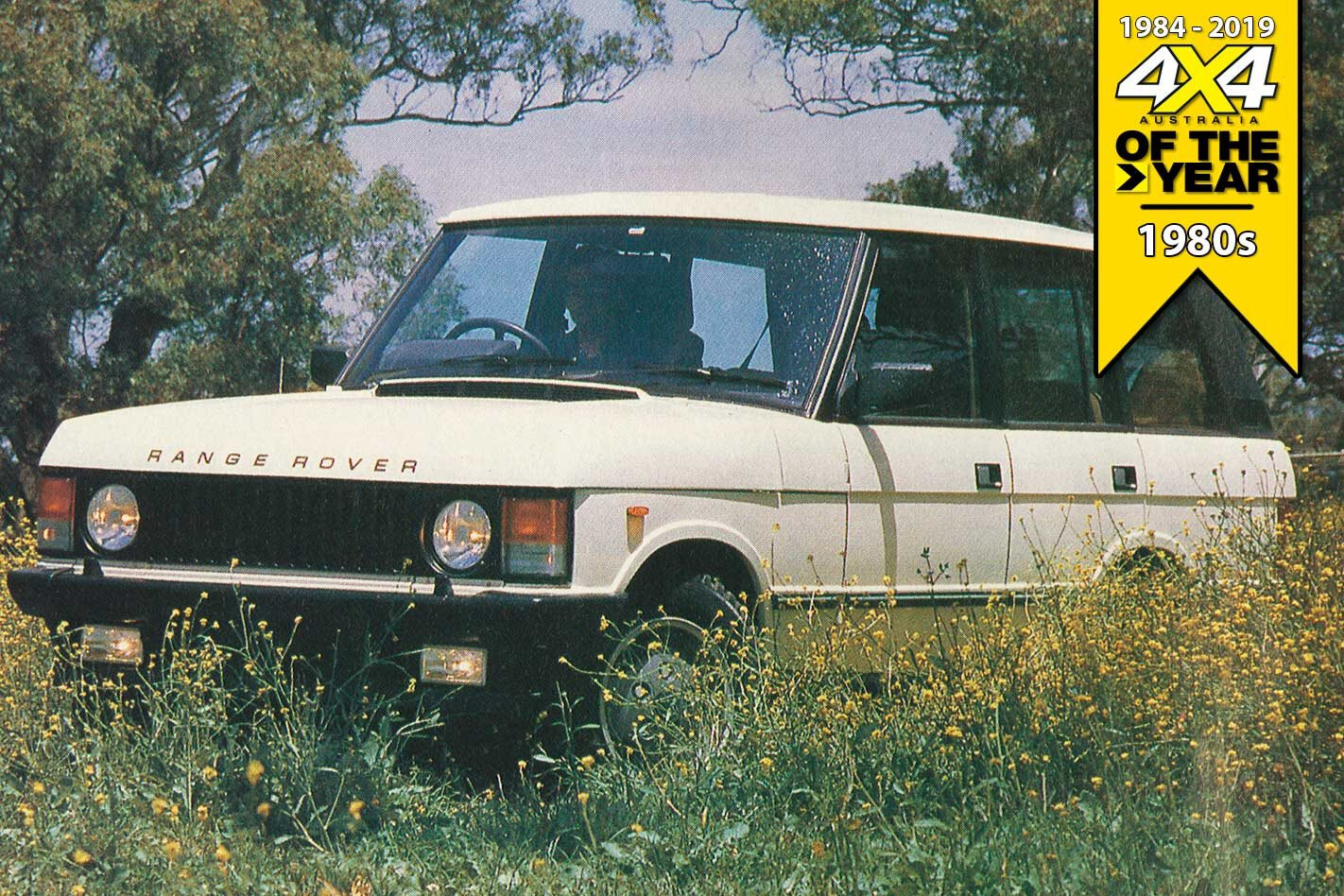 4x4OTY
4x4OTYPast 4x4OTY winners: 1980s
As we prepare to announce the 2019 4x4OTY, we step back into the past to see how it all began in the 1980s.
-
 4x4OTY
4x4OTYPast 4x4OTY winners: 1990s
The ’90s saw changes to the award and a return to form for a perennial winner.
-
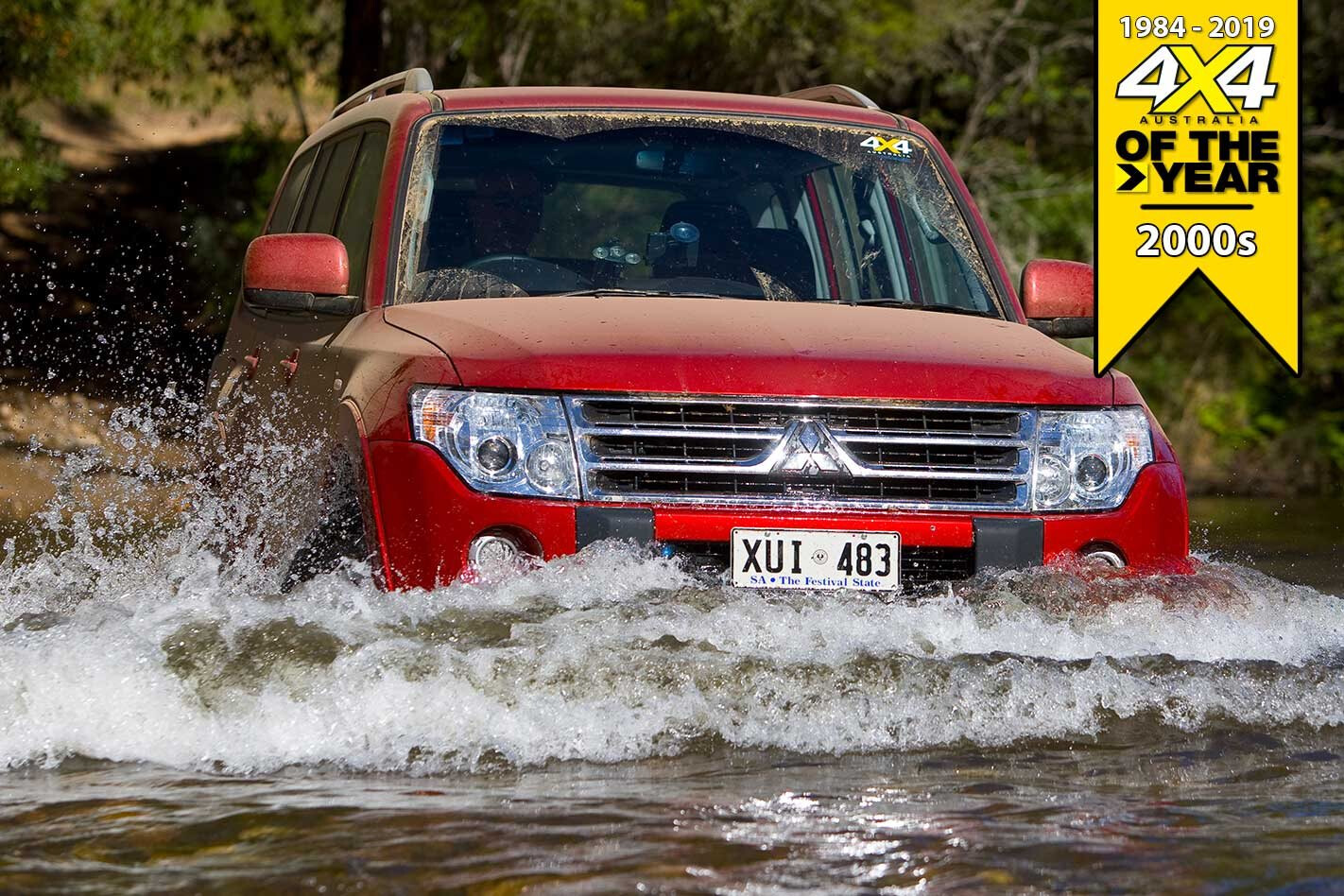 4x4OTY
4x4OTYPast 4x4OTY winners: 2000-2009
At the turn of the century the 4x4 industry was evolving at a rapid rate. Here are the best 4x4s of the naughties.
-
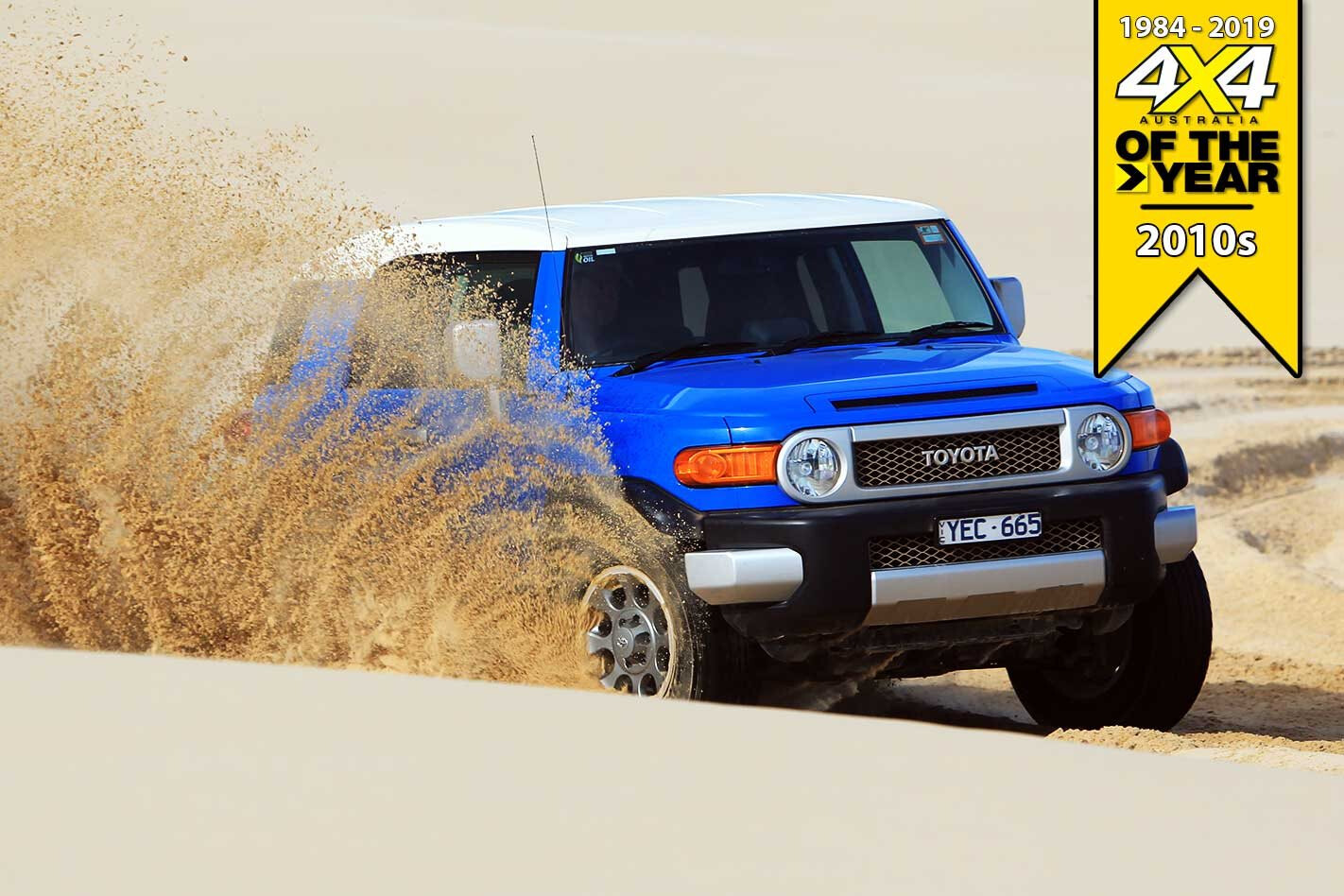 4x4OTY
4x4OTYPast 4x4OTY winners: 2010-2019
The last decade has seen the 4x4 world undergo a huge evolution.


